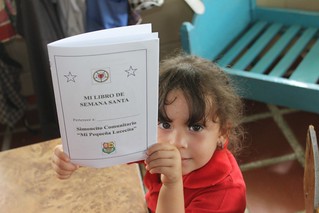 A meditation for the day of the Annunciation, March 25, 2015.
A meditation for the day of the Annunciation, March 25, 2015.Grace and peace in our Lord and Savior, Jesus Christ.
On Monday we began our activities with the preschool children to prepare them for Holy Week. The first activity in the Book of Holy Week that each received was coloring a picture of Jesus' triumphal entry into Jerusalem on Palm Sunday. We will celebrate Palm Sunday, the first Sunday of Holy Week, this next Sunday.
When they saw this drawing, children, without prompting, suddenly began to sing a Christmas song, "Mi Burrito Sabanero.”
Con mi burrito sabanero voy camino de Belén.
Si me ven, si me ven, voy camino de Belén.
And then:
Navidad,navidad,hoy es navidad.
Es un día de alegría y felicidad.
Why? In this picture Jesus is seated on a donkey, in the same way that in the drawings of the Virgin Mary, she is sitting on a donkey for the journey to Bethlehem with Joseph. In a sense this link is appropriate because today we remember the Annunciation, when the archangel Gabriel appeared to the Virgin Mary to greet her and announce that she would be the mother of the Savior.
In the historic church calendar, March 25 is the day of the Annunciation. Why do we remember this story of Christmas in the middle of Lent, the season of the suffering and death of our Lord?
A part of the answer is another question: Why do we celebrate Christmas on December 25? The Bible does not give a precise date of Jesus' birth. So why the December 25?
Today there is a great lie that the date, December 25, is derived from a pagan festival of worship of a god other than the Triune God. The truth is slightly more complicated, but it is important to understand.
A third question: Why is the date of Easter is variable? Why not celebrate Easter on the same date every year? Because Christ's Passover is linked with the Passover, which is the celebration of the Israelites' liberation from slavery in Egypt.
Our calendar, that of Spain and other European countries, is a form of the Roman calendar, which is based on the movements of the sun. The Hebrew calendar is based on the movements of the moon, so its months does not correspond exactly to those of our calendar. The date of Easter in our calendar follows the Hebrew calendar, so it varies according to our calendar.
However, according to an ancient calculation, the date of Passover in the year of Christ's death was March 25. So Christ died on March 25 and at the time of the Greco-Roman culture, people placed great importance on symmetry in the universe. For example, they believed that the deepest point of the sea should be equal to the height of the highest mountain in the world. Today we know that is not the truth, but it made sense to them.
It also made sense to them that Christ died on the same date that He was conceived, the day the Archangel appeared to Mary. So, according to this view, Christ died on March 25 and was conceived on March 25. And, what date is nine months after March 25? The 25th of December!
In this way they developed our church calendar. True, no one knows the exact date of the birth of Jesus Christ. Our church calendar, however, is a great tool to remember the life of Christ in the course of one year. And the whole life of Christ had only one purpose: to keep the Law of God in our place, suffer the punishment for our sins and die in our place on the cross. Because of His death, we have forgiveness of our sins, and because of his glorious resurrection on the third day, we have the promise of eternal life.
God has His will for our lives, to live as His sons and daughters. However, because of our sinful nature, none of us can fulfill God's law perfectly. But Christ has done so in our place, and suffered the punishment in our place. And because of His victory over sin and death, one day we are going to rise from the dead and live forever with Him,
For this purpose Jesus was born of the virgin Mary, and in the season of Advent, in preparation for Christmas, we remember His destiny. Also in this Lenten season, we give thanks for the gift of Jesus the angel announced first to Mary.
In this gift we hope for the future, so at this point, let us pray with confidence for the future of our children, for our country and for peace and the resolution of all our problems.
In Christ we have the peace that passes all understanding. Amen.
 |
| We celebrated the Annunciation with the preschool children and their famlies |

No comments:
Post a Comment